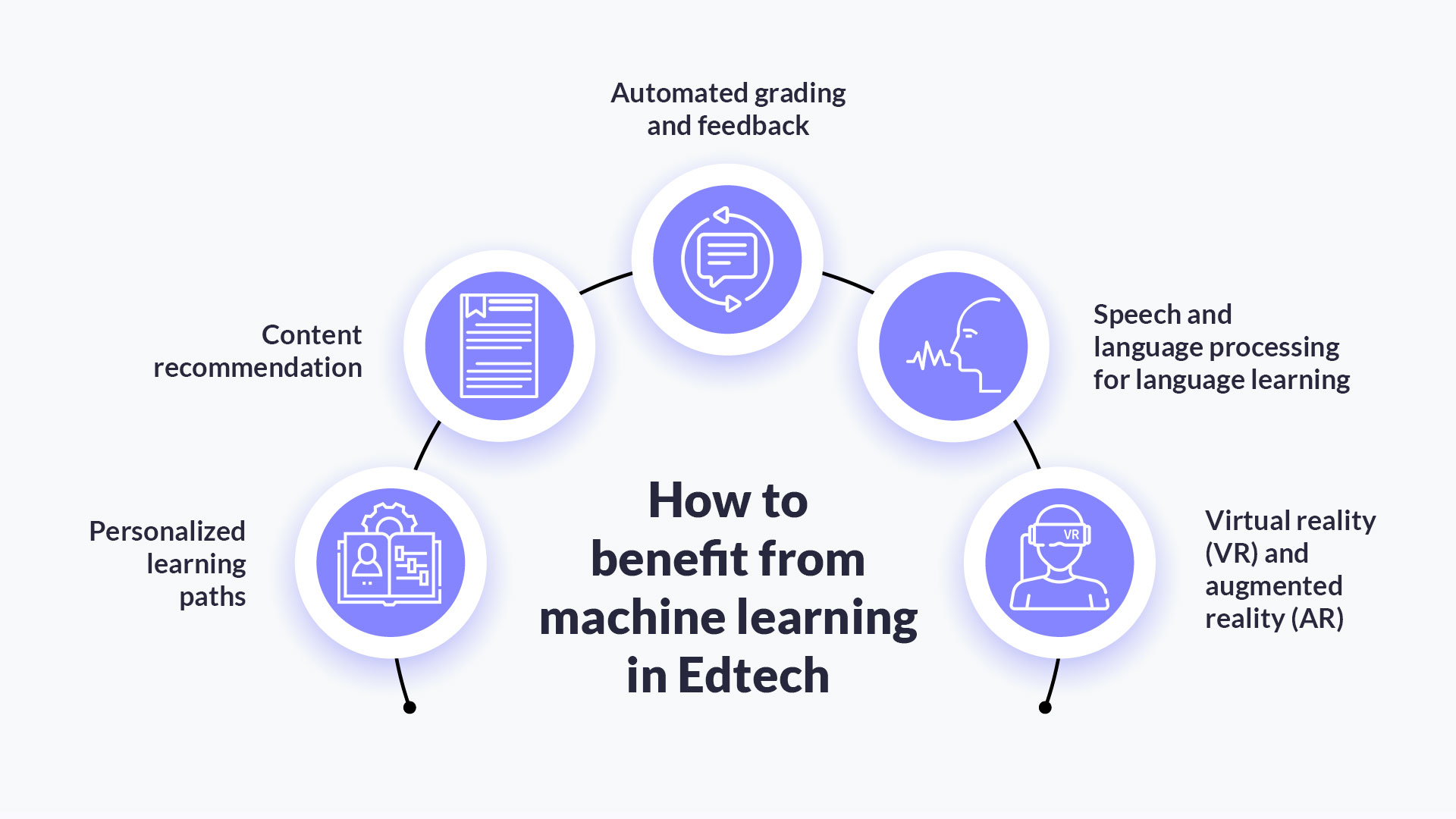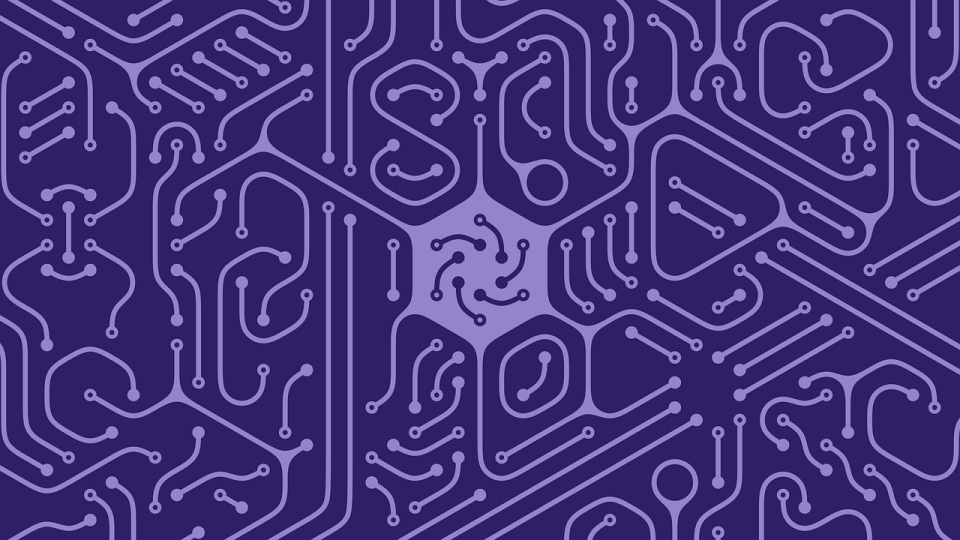- Personalized learning paths
- Intelligent content recommendation
- Automated grading and feedback
- Speech and language processing for language learning
- Virtual reality (VR) and augmented reality (AR) learning experience
- Overcoming challenges in ML adoption
- Conclusion
From ensuring the growth of your organization’s revenue to adopting new technological improvements, managers in the Edtech industry face numerous challenges every day.
What if we told you that machine learning in Edtech can solve many problems for you? With the application of machine learning in education, you can create innovative teaching methods, increase the efficiency of administrative tasks, and create personalized learning for individual students. Moreover, you can access actionable insights and data points to make the right decisions.
But what is this technology? Machine learning (ML), a sophisticated version of deep learning, is artificial intelligence that structures, tracks, and analyzes the data you use to make informed decisions. In this post, we’ll discuss five ways ML in education can help. You’ll also learn to tackle common challenges with ML adoption.
In this article:

Personalized learning paths
Not all students are the same. Before educational technology, students followed the predetermined learning paths of their institutions. This system is flawed because every student learns at a different pace.
Creating personalized learning paths is now possible thanks to machine learning and education. But what are these learning paths? Essentially, they are creating a more inclusive learning path so each student can learn at their own pace.
For example, a student struggling with mathematics may want more attention than other pupils. If the institution uses ML-based education software, the system will understand students' unique needs and suggest altering their learning path. Students' success will translate into your organization's success!
Here are the three biggest benefits for the education industry:
Enhanced learning outcomes: Since adaptive learning is imbued in personalized learning paths, students can understand a subject better and tackle their weak points.
Individualized recommendation: With machine learning applications in education, your institution can create individualization. Here’s how: it eliminates the tiresome process of analyzing every student and then devising a plan. Imagine having lessons and assignments specific to each student's goals, strengths, and weaknesses.
Catering to diverse learning styles: Some students learn faster than others. With personalized learning paths, you cater to each learning style specifically. Consequently, your students learn flexibly, resulting in higher satisfaction and more revenue.
Many educational platforms are creating tailored learning. For example, the Institute of Physics (UK and Ireland) uses Scoilnet, an online learning platform that lets institutions and tutors create custom learning paths for students.
Let's dazzle the future of education together!
Learn more about our Edtech services. We are open to bold, inspiring collaborations.
Intelligent content recommendation
Have you ever encountered an ad for a product you want to buy? This is an example of intelligent content recommendation in the advertising industry.
Interestingly, something similar happens in the Edtech industry. It is because of the use of machine learning in education. So, how do these new educational processes work?
The first step is to collect data from your students. From their learning activities, behaviors, scores, and backgrounds to the grades they’ve achieved — everything is noted. This unstructured data is then fed into machine learning tools.
Next, these tools filter out the data, group it, and present it in actionable steps. For instance, the technology will deploy content-based filtering to suggest similar content that the student had previously engaged in.
Here are two benefits that will convince you to use machine learning systems in your education institutions:
Enhances students’ comprehension: Education technology is data-driven, so it can accurately recommend additional readings for your students. This can include visualizations, case studies, explaining tricky questions, or linking to educational articles. Consequently, the student grasps the subject from different angles and formats.
Retention: Student retention is a vital metric that shows your institution imparts quality knowledge. Retention is an old problem, and organizations have tried various tactics to find solutions. Machine learning uses predictive analytics and, therefore, can increase student retention significantly. The technology assesses students’ weaknesses, matches their learning behavior, and presents content in the most digestible form.
A well-known Edtech startup, Knewton Alta (now acquired by Wiley), uses machine learning for education to create intelligent content recommendations for their students.


Thank you for Subscription!
Automated grading and feedback
If you’re a tutor, you know grading students' assessments and providing feedback is a hectic task. If the assessment involves a clear choice of right or wrong (for example, in MCQs), grading is easy. However, for more complex assignments, a tutor may need to check and analyze multiple times before providing feedback.
Fortunately, the role of machine learning in education can also extend to an “assessment specialist.” For MCQs and analyzing large blocks of text (such as essays), the technology uses natural language processing and its dataset to provide accurate feedback.
Let’s discover how it’ll benefit your institution:
Accuracy and consistency in grading: ML models are trained on a dataset to provide tailored recommendations. There’s a tiny chance of error when compared to a human. For instance, ML technology can flag areas after observing certain patterns in the assessment. This alerts the tutor where they need to examine deeper and help improve student performance with specific feedback.
Time efficiency for educators: Since this cutting-edge technology automates many mundane tasks, your educators will save time. Checking for logic, grammatical errors, sentence structure, and factual answers has become easy with these emerging technologies.
Personalized feedback for students: Vague feedback doesn’t help your students and hampers your institution's growth. However, when you apply machine learning in your educational institutions, it records the data of every student and traces their learning behavior. Consequently, your tutors can provide specific feedback and improve the student’s learning process.
One of the brightest machine learning in education examples of this type is Gradescope. It is an AI-assistant tool tutors use to speed up their grading procedures. Several American universities have already deployed this tool in their systems.

You may be interested
Virtual classroom advantages and disadvantages in online learning
Discover the changing world of education as we explore the good and not-so-good sides of virtual classrooms.
Read moreSpeech and language processing for language learning
If your academy teaches languages, machine learning algorithms can help you grow. The technology uses NLP to understand speech and semantics and compare them with real human voices. Duolingo is a world-famous language learning app that uses machine learning and NLP to do the same.
So, how does it typically work? For instance, Duolingo asks learners to speak into their smart device’s microphone. The recorded voice is analyzed by artificial intelligence, and the learner gets instant feedback. Further, the usage isn't limited to speech but also written texts. Imagine cutting costs by deploying automated tools like this in your educational academy.
Here are the top three benefits you will notice after using ML in your language Edtech platforms:
- Speech recognition technology helps your institution’s students and teachers identify the problem with sounds. Moreover, the tech automatically flags incorrect pronunciation and suggests the student try again, improving their learning.
- Since the ML software already has students’ data, it can help your academy create personal profiles and personalized education.
- The NLP and speech recognition technology also increases accessibility. It makes visually or auditorily impaired students feel more inclusive with your learning platform.
Virtual reality (VR) and augmented reality (AR) learning experience
Think of experiencing the grandeur and architectural beauty of the Taj Mahal without ever visiting it. How will that help history students? With the AR/VR tools of machine learning in the education industry, you can create such interactive environments.
Institutions often enable virtual reality experiences by using a VR headset. For AR experiences, a smart device, such as your iPhone, can be used in education.
Here’s how AR/VR is changing the old learning system:
Immersive learning environments: Imagine a student scans the skeleton of a human with their iPad, and the learning app immediately tells the anatomy. This is already happening—and you can create such an immersive learning environment with AR/VR.
Enhanced engagement: Since using machine learning in education platforms merges digital and physical environments, your students interact in real-time. It spikes creativity, stimulates the brain to learn more, and increases student engagement.
Accessibility and inclusivity: Disabled students can create a custom learning experience based on their needs and abilities. The students can learn complex concepts most tangibly in the comfort of their homes if they can’t attend your physical academy. This also opens global doors, increasing your institution’s reach and, thereby, your impact!
Great example: Mondly, a pioneer education app for language learners that uses VR and AR to help their students.

Some insights for you
Explore essential features that make administrative tasks easier and improve educational processes.
Discover more
Discover moreOvercoming challenges in ML adoption
By now, you have learned that there are major benefits of machine learning in education. Several Edtech companies are already using it, and you, too, must seize the opportunity. However, there are some tricky parts in ML adoption.
Let’s start with the most obvious: it’s hard to find the right technical expertise for the education sector. Every other IT company saying they’re the best doesn’t help you. We urge you to explore and do your due diligence before investing your money.
Further, deploying machine learning also raises privacy and data concerns. Your students and tutors may not want their data being tracked. There’s a clear need for awareness in that gray area.
So, what’s the solution? You can request our MLOps services, where we eliminate these pains. We have developers with decades of experience in developing AI applications. Notably, we’ve also worked with several renowned brands.
Conclusion
If you want to increase revenue and student retention and save your tutors’ time on administrative tasks, deploying machine learning algorithms in your organization can be a game changer.
You’ve learned several machine learning use cases in education and how they:
Create personalized learning,
Improve learning with tailored content recommendations,
Grade and assess for tutors,
Learn new languages,
Create immersive virtual environments using AR/VR.
The idea is simple: ML is a virtual assistant for your students and tutors while giving you the power to make the right decisions. You get crucial data that helps your organization grow in the Edtech industry while students are happy and satisfied. A win-win for all!





















